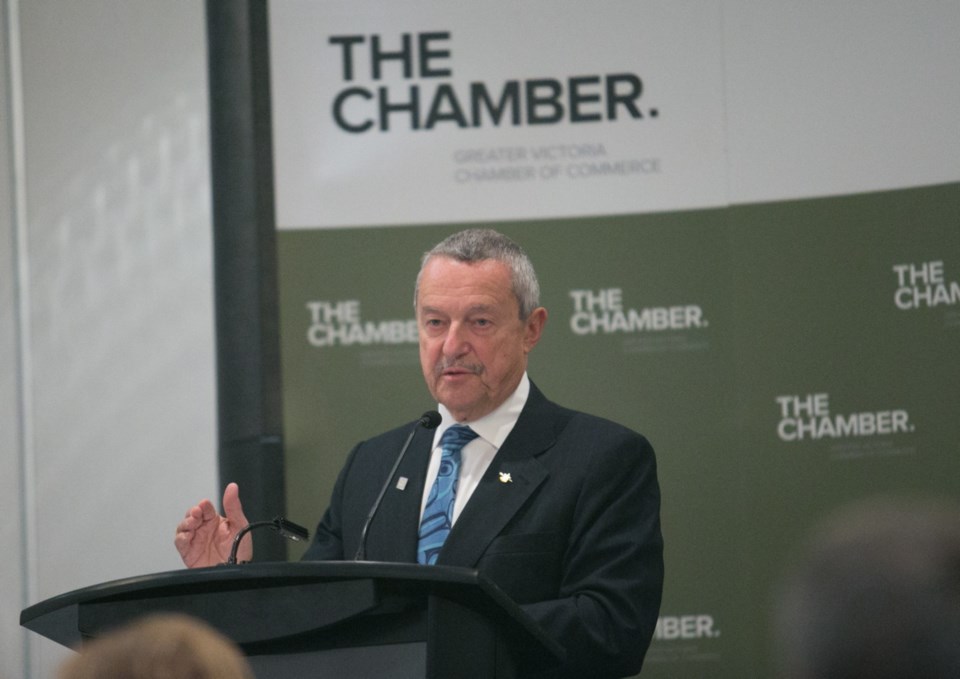It never was about forcing amalgamation on Greater Victoria, and Peter Fassbender knows it.
B.C.’s community charter already bars the provincial government from imposing amalgamation on anyone.
No, all that people are asking for is a study into whether amalgamation makes sense.
But Fassbender, the cabinet minister responsible for B.C.’s municipal governments, wouldn’t even commit to that. Instead, speaking to the Greater Victoria Chamber of Commerce, he merely promised to bring together local mayors — many of whom stand like a dam between the voters and their expressed desire for more information. Leaving the question of regional governance to our 90-odd mayors and councillors is like leaving bank security to John Dillinger.
Without real leadership from the province, nothing will happen — a reality reflected in the Victoria Police Department’s five-year strategic plan, released Tuesday.
Noticeably absent from the document was any mention of a regional police force. That’s in stark contrast to the last VicPD strategic plan, drawn up in 2011, which included the goal of an amalgamated department by 2020.
VicPD has been banging the amalgamation drum for years. For the cops, the big issue is their ability to do their job, the idea that the region’s patchwork policing creates artificial barriers that criminals don’t face. For politicians, it has been more about the money.
The City of Victoria and its sometimes-reluctant policing partner, Esquimalt, have long complained that they do a disproportionate amount of the heavy lifting for what is, in practice, a medium-sized city of 335,000. As with any such city, street crime and social problems are concentrated downtown — the difference being that in Greater Victoria, the associated costs are borne solely by those who live near the action.
Their arguments are backed up by B.C. Justice Ministry statistics. In 2013, VicPD had 243 officers covering two municipalities with a combined population of 100,000. The cost worked out to $461 per person in Victoria and $425 in Esquimalt.
By contrast, the other 235,000 people were policed by about 300 officers spread from Metchosin to North Saanich.
The cost of the region’s other three municipal departments — Saanich, Oak Bay and Central Saanich — ranged from $245 to $263 per capita.
The Mounties, with detachments covering the West Shore and Sidney-North Saanich, were the real bargain. The smallest communities, Metchosin and Highlands, didn’t pay for policing at all, while per capita costs in the rest went from a low of $122 in View Royal to a high of $204 in Sidney.
Of course, while Victoria and Esquimalt might see this disparity as an excellent reason to share the cost of policing more equitably, the other municipalities see it as a totally awesome reason to leave things as they are. Why would Langford, whose residents pay just $141 apiece for the RCMP, voluntarily eat a cost hike?
Both Victoria Mayor Lisa Helps and Esquimalt Mayor Barb Desjardins recognize this reality.
“You can talk all you want about things being unfair, but that’s not going to get people to buy in,” Desjardins says.
Or, as Helps put it: “Who wants to partner with somebody who’s got all the problems?”
Likewise, it’s obvious that the provincial government, the only one with enough muscle to force a solution, has no interest in doing so. Hence the change in direction. No mention of amalgamation in the VicPD plan.
Instead, we now see Helps and Desjardins taking a softer approach. In June, they quietly approached the other local municipal police boards — Central Saanich, Oak Bay and Saanich — to talk about ways to co-operate. They altered the language, dropping the A-word. Instead, they frame the conversation as one about ways to provide better safety for the region. “It’s a change of tone,” Helps says.
Out of this has emerged a working group with one rep from each board. It is to meet again Dec. 2.
Desjardins says they eventually want to involve the municipalities policed by the RCMP, too, though how that would work is uncertain, since the Mounties aren’t governed by local police boards.
If all this looks like yet another fruitless exercise in herding cats, well, what’s the alternative?
“Politics is the art of the possible, the attainable — the art of the next best,” Otto von Bismarck said. With the provincial government having no stomach for the job, this is all that’s left.
> Editorial: Amalgamation leadership vital, A10



